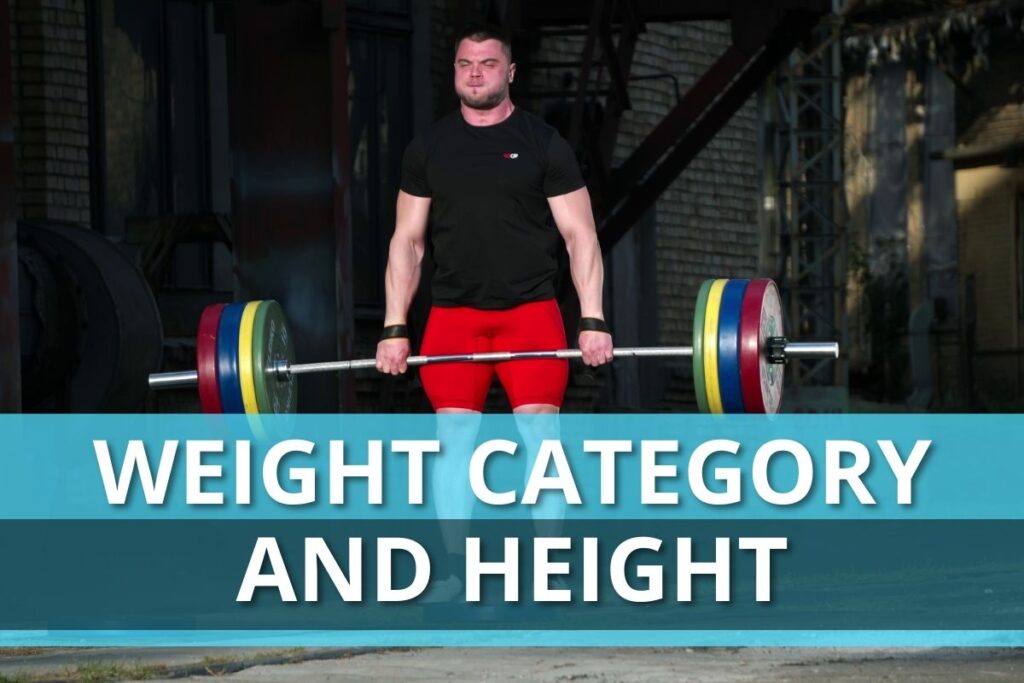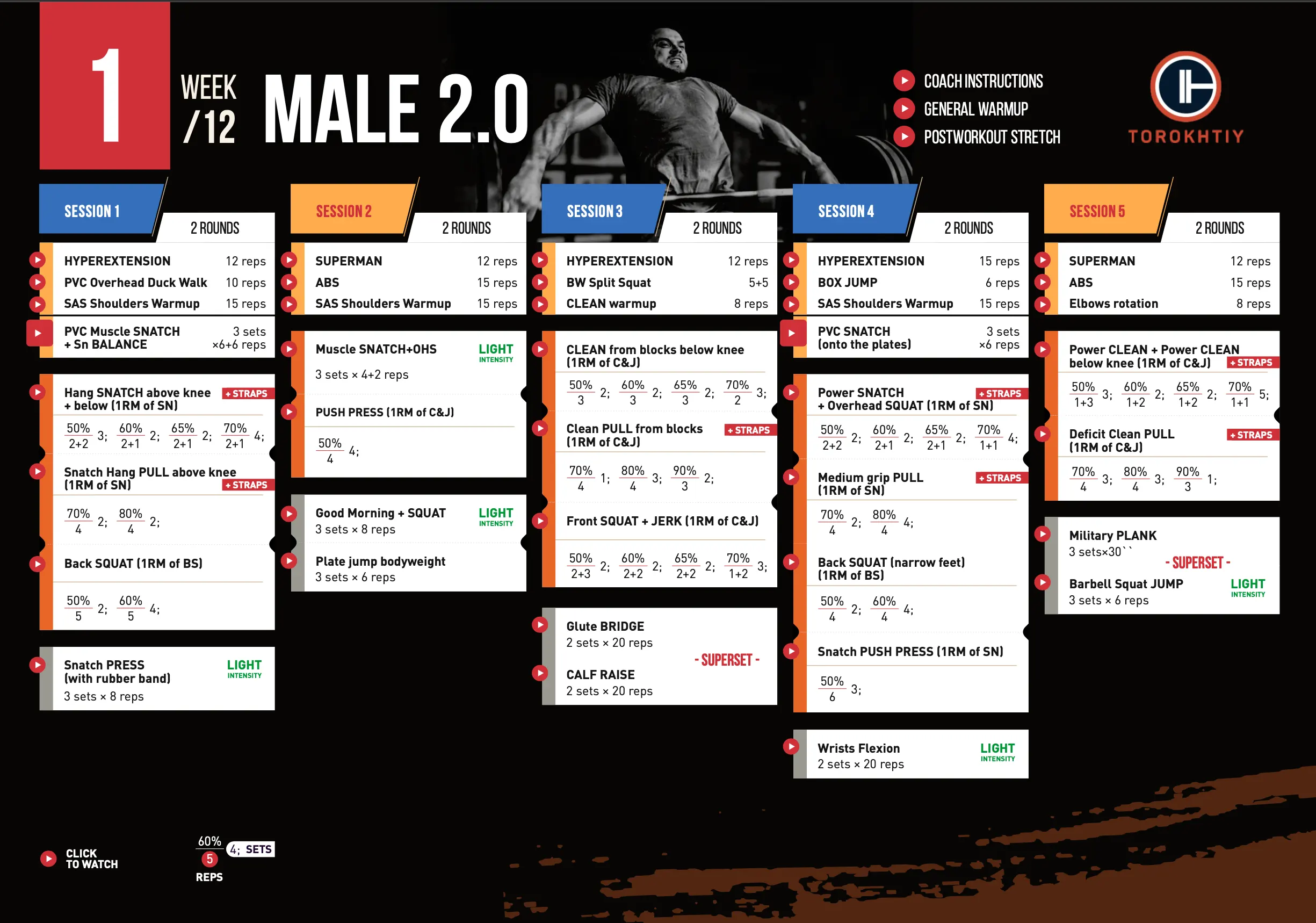Weight Category and Height
Author:
Unlock your full potential by engaging with our experts and community! Have questions about your fitness journey or looking for expert advice on weightlifting techniques? Don’t hesitate — leave a comment below and Sergii Putsov will provide a personalized answer and insights to help you reach your goals.
Torokhtiy is reader-supported. Some links are affiliate links, and we may earn a commission at no extra cost to you. See our disclosure page for details.
The frequently asked question is: “How much do I need to weigh and in what weight category should I perform?” The answer to this question is not, “whatever feels right.” Trainers and scientists alike have been searching for an answer to this question for many years.

Experience in weightlifting has shown that those athletes whose body metrics meet the requirements of the weight category they choose to perform in will reach high athletic performance. That is, under equal conditions, those weightlifters whose body length and upper and lower limb length are less than their rival’s, are more likely to win.
Known experts in weightlifting [Chernyak, 1978; Medvedev, 1986; Dvorkin, 2005; Oleshko, 2014] have made numerous attempts to determine the optimal body weight values for weightlifters of different categories who have achieved world class results on the international arena. Below are the average body dimensions of world class weightlifters.
Body Dimensions for World Level Weightlifters
at the XXIX and XXX Olympics
| Weight category, kg | height, сm (ft`inch“) | ||||
| Champions | Top 6 | All athletes | European athletes | Asian athletes | |
| MEN | |||||
| 56 | 156 (5`1“) | 155 (5`1“) | 158 (5`2“) | 160 (5`3“) | 157 (5`2“) |
| 152 (4`12“) | 154 (5`1“) | 157 (5`2“) | 163 (5`4“) | 155 (5`1“) | |
| 62 | 161 (5`3“) | 161 (5`3“) | 159 (5`3“) | 161 (5`3“) | 160 (5`3“) |
| 158 (5`2“) | 162 (5`4“) | 159 (5`3“) | 160 (5`3“) | 158 (5`2“) | |
| 69 | 168 (5`6“) | 164 (5`5“) | 165 (5`5“) | 167 (5`6“) | 165 (5`5“) |
| 167 (5`6“) | 165 (5`5“) | 165 (5`5“) | 167 (5`6“) | 164 (5`5“) | |
| 77 | 165 (5`5“) | 165 (5`5“) | 169 (5`7“) | 170 (5`7“) | 166 (5`5“) |
| 172 (5`8“) | 171 (5`7“) | 171 (5`7“) | 171 (5`7“) | 171 (5`7“) | |
| 85 | 172 (5`8“) | 173 (5`8“) | 171 (5`7“) | 172 (5`8“) | 173 (5`8“) |
| 170 (5`7“) | 175 (5`9“) | 173 (5`8“) | 173 (5`8“) | 173 (5`8“) | |
| 94 | 175 (5`9“) | 175 (5`9“) | 175 (5`9“) | 175 (5`9“) | 172 (5`8“) |
| 174 (5`9“) | 176 (5`9“) | 176 (5`9“) | 178 (5`10“) | 173 (5`8“) | |
| 105 | 172 (5`8“) | 177 (5`10“) | 176 (5`9“) | 179 (5`10“) | 173 (5`8“) |
| 181 (5`11“) | 180 (5`11“) | 180 (5`11“) | 180 (5`11“) | 178 (5`10“) | |
| 105 | 183 (6`) | 186 (6`1“) | 183 (6`) | 184 (6`) | 186 (6`1“) |
| 197 (6`6“) | 190 (6`3“) | 186 (6`1“) | 188 (6`2“) | 185 (6`1“) | |
| WOMEN | |||||
| 48 | 152 (4`12“) | 149 (4`11“) | 149 ( 411“) | 152 (4`12“) | 149 ( 4`11“) |
| 150 (4`11“) | 147 (4`1“) | 150 (4`11“) | 156 (5`1“) | 147 (4`1“) | |
| 53 | 157 (5`2“) | 155( 5`1“) | 153 (5`) | 154 (5`1“) | 154 (5`1“) |
| 155 (5`1“) | 156 (5`1“) | 154 (5`1“) | 156 (5`1“) | 154 (5`1“) | |
| 58 | 158 (5`2“) | 157 (5`2“) | 157 (5`2“) | 160 (5`3“) | 154 (5`1“) |
| 161 (5`3“) | 156 (5`1“) | 157 (5`2“) | 157 (5`2“) | 157 (5`2“) | |
| 63 | 155 (5`1“) | 161 (5`3“) | 161 (5`3“) | 162 (5`4“) | 161 (5`3“) |
| 161 (5`3“) | 164 (5`5“) | 162 (5`4“) | 165 (5`5“) | 159 (5`3“) | |
| 69 | 160 (5`3“) | 165 (5`5“) | 163 (5`4“) | 164 (5`5“) | 161 (5`3“) |
| 163 (5`4“) | 161 (5`3“) | 161 (5`3“) | 161 (5`3“) | 160 (5`3“) | |
| 75 | 168 (5`6“) | 167 (5`6“) | 166 (5`5“) | 165 (5`5“) | 168 (5`6“) |
| 165 (5`5“) | 165 (5`5“) | 165 (5`5“) | 165 (5`5“) | 163 (5`4“) | |
| 75 | 171 (5`7“) | 174 (5`9“) | 171 (5`7“) | 173 (5`8“) | 170 (5`7“) |
| 175 (5`9“) | 174 (5`9“) | 171 (5`7“) | 176 (5`9“) | 169 (5`7“) | |
Data analysis: Table 1 shows that body length for weightlifters increases with the increase of groups of weight categories – by 1.6%. The average group weight gain in heavyweight (+ 105, +75) weight categories, in comparison to the athletes of the light (56, 48) categories, in Beijing – 15.8%, and at XXX Olympics – 18.5% .
You may like it:
- Detailed Olympic Weightlifting Program For Beginners
- 12-Week Weightlifting Program For Women (Detailed Example)
- Create Your Olympic Weightlifting Program (Examples Included)
Comparative analysis of body length indicators of men and women of the same weight categories shows a paradoxical situation, which refutes some commonly held assumptions in the growth of the body of athletes of different sexes. At the XXX Olympiсs, body length of all women in the weight category up to 63 kg is higher by 3.0 cm (1.9%) in comparison to the body weight of men in the weight category up to 62 kg.
At the XXIX Olympics, in the weight category up to 77 kg in men and 75 kg in women is similar. Body length of female champions is greater than that of the male champions – 3.0 cm (1.7%). At the same time, there are no statistically significant differences in the comparison of general data.
Therefore, it can be said that all athletes of identical male weight categories are not inferior to indicators of the body length of men.
Follow us!

Free!
Get a 2-week Weightlifting Program as a bonus for the subscription to kickstart your training plan!

Free!
Comparative characteristics of body length of athletes of different sexes among representatives of European and Asian countries show that weightlifters from Asia in all weight categories have a smaller height on average for men by 1-8 cm (1.4%), and among women – by 1-9 cm (1.8%).
Based on this information, we can make a conclusion that adult athletes (men – 23-28 years, women – 20-27 years) who are at the peak of their physical capabilities should focus on the average data of Olympic weightlifters. Junior athletes often perform in 1-2 weight categories lighter and gain weight as the grow older – this allows them to progress as a result.
You might be interested in:
Why Trust Us?
With over 20 years in Olympic weightlifting, strength training, nutrition coaching, and general fitness our team does its best to provide the audience with ultimate support and meet the needs and requirements of advanced athletes and professional lifters, as well as people who strive to open new opportunities and develop their physical capabilities with us.
By trusting the recommendations of our certified experts in coaching, nutrition, and sports training programming, as well as scientific consultants, and physiotherapists, we provide you with thorough, well-considered, and scientifically proven content. All the information given in the articles concerning workout programming, separate exercises, and athletic performance, in general, is based on verified data.
The product testing process is described in more detail here.
Author: Sergii Putsov
Head of Sport Science, PhD
Best Results: Snatch – 165 kg,
C&J – 200 kg
Sergii Putsov, Ph.D., is a former professional weightlifter and National team member, achieving multiple medals in the 94 kg weight category at national competitions. With a Master’s degree in “Olympic & Professional Sport Training” and a Sport Science Ph.D. from the International Olympic Academy, Greece, Sergii now leads as the Head of Sport Science. He specializes in designing training programs, writing insightful blog articles, providing live commentary at international weightlifting events, and conducting educational seminars worldwide alongside Olympic weightlifting expert Oleksiy Torokhtiy.




Still have questions after reading our article? Unlock your full potential by engaging with our experts and community! Don’t hesitate — leave a comment below and Sergii Putsov will provide a personalized answer and insights to help you reach your goals.